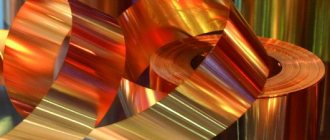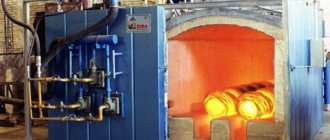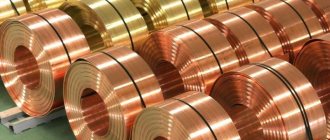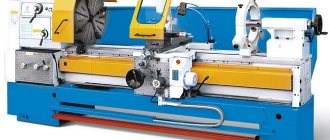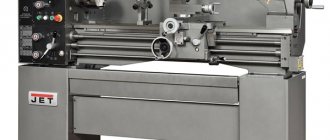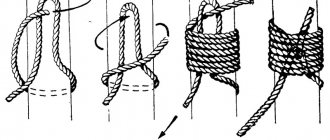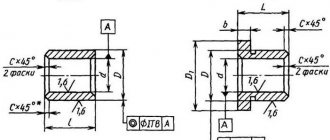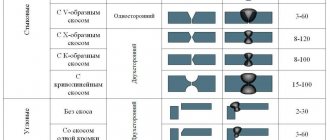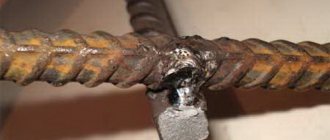Metals, alloys, special alloys, slag-forming additives and other materials that are used to prepare various alloys are called charge materials or charge in the foundry industry. The charge includes: fresh materials (blast furnace cast iron of various grades, copper, aluminum, zinc, nickel, etc.), which come to foundries from metallurgical plants; scrap of ferrous alloys and scrap of non-ferrous alloys, which are processed industrial wastes; special ferroalloys and alloys (intermediate alloys of more refractory elements with low-melting elements) coming from metallurgical plants; waste from foundries and machine shops (sprues, profits, defective parts and briquetted shavings). The quantitative ratio of various materials in the charge depends on the quality of the starting materials and on the requirements for the manufactured alloys.
Main types of melting furnaces
In foundry production, melting furnaces operating on solid, liquid or gaseous fuels (coke, oil, fuel oil, gas) and electric furnaces are used. The first type of furnaces includes cupola furnaces and crucible furnaces, the second type includes electric arc furnaces and electric induction furnaces. The most widely used furnaces for melting cast iron are shaft-type furnaces—cupola furnaces. Gray cast iron produced in these furnaces is used for casting parts of various complexity. Electric furnaces melt steel, alloy cast iron, and white cast iron, which is then processed into malleable cast iron. The cupola furnace diagram is shown in Fig. 35. The cupola is a shaft furnace, the basis of which is a welded metal casing 1, lined on the inside with refractory bricks 2. The gap between the casing and the lining is filled with dry quartz sand 3. There is a loading window in the upper part of the cupola 4. Part of the cupola shaft located below the loading window , is lined with cast iron hollow bricks 5, which protect it from destruction when loading the charge 7.
Load the cupola using a skip hoist or jib crane. The upper part of the cupola ends with spark arrester 6.
To maintain combustion in the cupola furnace, air (blown) is supplied through special holes 8, called tuyeres, and blown by a fan. Molten cast iron along the hearth 9, located in the lower part of the shaft, flows through a special hole and chute into the reservoir 10. At the beginning of work, a layer of coke 500-1500 mm high is loaded into the cupola and ignited. This layer of coke is called blank shell. Then the working coke shell, flux and the first portion of the metal charge are loaded onto the idle shell. After loading the materials, the air necessary for combustion of the fuel is supplied through the tuyeres. In the melting belt, cast iron and slag are melted and flow into the cupola furnace. The resulting gases, rising upward, heat the metal charge and fuel, and then go into the pipe.
As the coke burns and the cast iron melts, the charge loaded into the cupola falls down, and new portions of charge materials are loaded in its place. During the melting process, liquid iron accumulates in the cupola furnace. The slag floats to the surface of the cast iron and is periodically released through the slag tap hole. The accumulated cast iron is drained through a tap hole along a chute into a special storage tank, and then into a ladle. The productivity of cupola furnaces is 0.5–30 tons of cast iron per hour.
For the purposes of fire safety and protection from pollution of the surrounding area, cupola furnaces are equipped with spark arresters, which are also dust collectors.
For melting steel, foundries use open-hearth and electric arc furnaces with basic and acid linings, as well as induction crucible furnaces.
In Fig. Figure 36 shows a diagram of an electric arc furnace. The heat source in this furnace is an electric arc that occurs between the melt 3 located in the bath of the furnace 4 and three graphite electrodes 1 (passing through the roof of the furnace 6), through which an electric current is supplied. The capacity of such furnaces is 1.5-10 tons. Melting duration is 1.5-4 hours. The prepared metal is poured when the furnace is tilted, carried out by a special mechanism, through chute 5. The charge is loaded into the furnace through window 2 or through the furnace roof, raised and rotated by a special mechanism.
Melting steel in an electric arc furnace consists of the following operations: filling the electric furnace, filling the charge, melting the charge and casting the finished steel.
An induction furnace (Fig. 37) consists of a frame 6 made of non-magnetic material, inside of which there is an inductor (coil) made of turns 7 of a copper tube through which cooling water flows. The turns are separated from each other by insulation '8. The melting crucible 5 in this furnace is made of a stuffed lining. The upper parts of the lining 1 and 3 and its lower part 4 are made of shaped refractory bricks, layer 2 is made of refractory coating. The heat source in these furnaces is an induction current excited in the charge loaded into the crucible when an alternating current of high frequency is passed through an inductor.
Read also: DIY accessories for woodworking machines
Rice. 38. Single-phase electric arc furnace for melting copper alloys
Melting of non-ferrous alloys is carried out in crucible furnaces with oil or gas heating, in electric resistance furnaces, as well as in arc or induction electric furnaces.
Copper alloys are melted in crucible, flame and electric furnaces. The most widely used are single-phase electric arc furnaces of the DMK type (Fig. 38). The furnace is a metal drum 1, lined with refractory bricks 2. The heat required to melt copper is created by an electric arc arising between two horizontally located electrodes 3. Mounted on rollers 4, drum 1 can be rotated to a certain angle by a motor and a gear drive.
Charge materials are loaded through a working window equipped with a chute through which the finished melt is released. For the smelting of copper alloys, the charge materials are pigs, machine scrap, waste from own production, etc. During the smelting process of copper, zinc and lead, harmful gases and vapors are released, so smelting furnaces are equipped with powerful exhaust ventilation.
Aluminum alloys are melted in crucible and flame furnaces, electric resistance furnaces and induction furnaces. In Fig. 39 shows a gas-heated crucible furnace for melting aluminum alloys. The furnace has a refractory lining 1, inside which a cast iron crucible 2 is inserted. Gas is supplied to the burner 4 and burns in the space between the lining and the crucible. Hole 3 is provided for releasing metal when the crucible burns out. Combustion products and gases from the alloy are removed by an exhaust hood 5. The furnace is suspended by axles on side supports and can be tilted using a steering wheel and a worm gear.
Unlike industrial equipment, a homemade furnace for melting metal is a compact device. Such portable equipment can be used to smelt, harden or smelt non-ferrous metals.
Melting metal and cast iron
A furnace for melting metal is a body made of fireclay bricks. The binding element is clay. The firebox is designed to burn coal. There is a hole at the bottom through which the air is blown into the inferno. At the bottom there is a cast iron grate called a grate. Coke or coal is laid out on it. It can be removed from the old stove. Sometimes refractory bricks are laid on edge when forming the body. The finished structure is fastened from the outside with a metal belt.
A furnace for melting metals must have a crucible. It can be an enameled or cast iron cauldron. The location of the crucible is next to the burning coke. To improve airflow, a fan is installed nearby. The equipment is used for steel smelting, but can be used as a furnace for cast iron smelting.
Furnaces for preparing and melting cast alloys
An induction furnace consists of a refractory crucible that holds from 1 to 30 tons of melt. Metals loaded into the furnace are heated and melted due to the heat generated in the metal itself during the conversion of electrical energy induced by a special winding (inductor) surrounding the crucible from the outside.
A vacuum arc furnace consists of a water-cooled crucible (crystallizer) made of an alloy of the same composition as that melted in the furnace, or of copper. The crystallizer is sealed and connected to a chamber under vacuum, which ensures high quality of the alloys produced in the furnace. Alloys are obtained by melting a consumable electrode under the action of an electric arc.
Electric furnaces for melting metal
The basis of such a stove is asbestos, which can be replaced with tiles. Electrodes installed in a melting furnace with your own hands must have a voltage of 25 V.
They are made in the following order:
- They are machined from the brushes of an electric motor.
- 6 mm holes are drilled into the assembly.
- A wire with a cross section of 5 mm is passed through them.
- A nail is driven in to secure the wiring.
- In order to improve contact with graphite, the file makes notches.
Mica is placed inside the furnace as a heat insulator. When connecting to the network, you need to use a step-down transformer. After production, the oven turns on and runs for some time in idle mode.
Remelting furnaces
Plasma, electron beam, electroslag and vacuum arc furnaces of some types operate on consumable electrodes, specially smelted in other units. Therefore, furnaces of these types are often classified as a special group of remelting furnaces . Some types of remelting furnaces, due to their relatively simple design, are called installations, for example, electroslag remelting installations.
Electric furnaces are also classified according to a number of other characteristics: design, type of lining, etc.
Muffle furnace
Muffle furnaces are often used for heat treatment of parts. Such equipment is characterized by a wide temperature range, from 20 to 1000 degrees.
A muffle furnace for hardening metal operates on different types of energy. However, at home it is better to use a unit that runs on electricity. Hardening is carried out in the furnace muffle.
A muffle furnace is made with your own hands in several stages:
- The muffle is made from fireclay bricks. Due to the round shape of the oven body, their corners are beveled. In each brick, grooves are selected where the spiral is laid.
- If the muffle furnace for melting is made from an oven, then the inside is lined with fire-resistant bricks. Grooves for the spiral are cut into the masonry.
- The chamber, made of refractory brick, is placed in a housing made of steel. Insulation is placed on the bottom. The gap between the side walls of the chamber and the housing is 4 cm, where the insulation is inserted. The top consists of 2 layers of metal and insulation.
- Holes are drilled in the housing, and the ends of the spiral are brought out through them, which are connected to the network cable.
- When using an oven, no insulation is required. It is already provided for in it.
Read also: Lathe 1u61 technical characteristics
DIY induction oven
Furnaces operating on the principle of electromagnetic induction came into everyday life from industry.
In the metallurgical industry they are used for melting non-ferrous and ferrous metals.
Of course, in order for induction heating devices to become suitable for use in domestic conditions, their design has undergone a number of fundamental changes. Only the principle of energy conversion remained unchanged.
Let's look at how you can make a simple induction oven with your own hands.
During manufacturing, it is necessary to remember some important points that affect the speed of metal cutting.
This:
- power;
- frequency;
- eddy losses;
- heat transfer intensity;
- hysteresis losses.
The design of the inductor is very simple.
Its center is an electrically conductive workpiece, usually graphite or metal.
A wire is wound around the workpiece. Power is supplied from a powerful generator capable of running currents of different frequencies.
As a result, an electromagnetic field is formed around the inductor. This, in turn, creates eddy currents in the workpiece. Under the influence of currents, graphite and metal become very hot and their heat is transferred to the surrounding air of the room.
When the induction heater operates, a high temperature is generated. This is precisely why such furnaces are used in industry.
The resulting temperatures are sufficient for melting and surface hardening of metals, and heat treatment of metal workpieces.
Inductors began to be used in everyday life relatively recently.
It is necessary to correctly select all the necessary details of the circuit to obtain sufficient conditions for melting in the workshop.
If the unit is assembled with your own hands, the generator frequency should be 27.12 MHz. The coil should be made of wire or thin copper tube, and there should not be more than 10 turns.
The power of vacuum tubes must be high.
The scheme involves installing a neon lamp, which will be used as an indicator of device readiness. The circuit also provides for the use of chokes and ceramic capacitors.
The connection to the home outlet is made through a rectifier.
A home-made induction furnace looks like this: a small stand on legs to which a generator with all the necessary circuit parts is attached. And the inductor is connected to the generator.
A homemade induction furnace is not fraught with any difficulties so that an ordinary person with at least a little knowledge of electrical engineering could not assemble it.
It has only three main blocks:
- Generator.
- Inductor.
- Crucible.
The inductor is a copper winding that you can make yourself. You will have to look for the crucible either in the appropriate stores or get it in other ways. And the following can be used as a generator: a welding inverter, a self-assembled transistor or lamp circuit.
Homemade induction furnaces are most often used for heating rooms.
Small crucible structures are well suited for melting and processing metals in small volumes, for example, when making jewelry or costume jewelry yourself.
An induction cooker is an ideal solution for a country house. Even in a city apartment, homemade products have found their application. They can be used as an additional heater in case of failures in the central heating system.
Industrial smelting plants are equipped with a forced cooling system using water or antifreeze.
Carrying out water cooling at home will require additional costs comparable in price to the cost of the metal melting installation itself.
Air cooling using a fan is possible if the fan is located far enough away.
Otherwise, the metal winding and other elements of the fan will serve as an additional circuit for closing eddy currents, which will reduce the efficiency of the installation.
An important issue when using an induction furnace is safety. When using a home-made induction furnace, it is necessary to take measures to protect the user of the furnace from possible high-frequency radiation and take into account the possibility of burns from the inductor.
Induction furnace on a welding inverter
The simplest and most widespread option. Efforts will have to be expended only on the construction of the inductor.
Take a thin-walled copper tube 8-10 cm in diameter and bend it according to the desired pattern. The turns should be spaced at a distance of 5-8 mm, and their number depends on the characteristics and diameter of the inverter.
The inductor is fixed in a textolite or graphite casing, and a crucible is placed inside the installation.
An induction furnace, created on the basis of an inverter, does not have any settings that would allow people to set the desired water temperature. Therefore, we can say that this equipment is not completely safe for continuous use.
Therefore, it is best to provide for the installation of automation and control devices during the process of forming an induction furnace. In this case, you can not only increase the safety of the device, but also simplify its use, and repairs will be required very rarely.
To prevent overheating during use of the equipment, it is necessary to install an emergency shutdown element, which can be controlled using a thermostat.
A thermostat equipped with a temperature sensor can be installed.
You can install a relay that opens the circuit if the coolant temperature reaches a certain level.
Transistor induction furnace
In this case, you will have to work not only with your hands, but also with your head. And run around the shops looking for the necessary spare parts. After all, you will need transistors of different capacities, a couple of diodes, resistors, film capacitors, two copper wires of different thicknesses and a couple of inductor rings.
- Before assembly, it is necessary to take into account that the resulting circuit will become very hot during operation. Therefore it is necessary to use fairly large radiators.
- Capacitors are assembled in parallel into a battery.
- Copper wire with a diameter of 1.2 mm is wound onto the throttle rings. Depending on the power, the turns should be from 7 to 15.
- A cylindrical object, suitable in diameter to the size of the crucible, is wound with 7-8 turns of copper wire with a diameter of 2 mm. The ends of the wire are left long enough for connection.
- According to a special scheme, everything is mounted on the board.
- The power source can be a 12-volt battery.
- If necessary, you can make a textolite or graphite case.
- The power of the device is adjusted by increasing or decreasing the turns of the inductor winding.
Assembling such a device yourself is not easy. And you can take on this work only if you are confident in the correctness of your actions.
Induction furnace with lamps
Unlike a transistor oven, a lamp oven will be much more powerful, which means you will have to handle both it and the circuit more carefully.
- 4 beam lamps connected in parallel will generate high frequency currents.
- Copper wire is bent into a spiral. The distance between the turns is 5 or more millimeters. The coils themselves are 8-16 cm in diameter. The inductor should be of such a size that the crucible can easily fit inside.
- The inductor is placed in a housing made of a non-conducting material (textolite, graphite).
- You can put a neon indicator lamp on the body.
- You can also include a tuning capacitor in the circuit.
You can make an induction furnace yourself, but this is not always advisable. It is better not to take on such work if you have absolutely no knowledge in the field of electrical equipment and physics.
Before you begin to construct even the simplest device, it should be developed, designed and diagrammed. If you have no experience in manufacturing electrical appliances, it is best to purchase such a factory-made unit.
Aluminum smelting
Making a furnace for melting aluminum with your own hands is a real thing. In industrial production, units with the name - rotary-type ovens - are very expensive.
To understand how to make a furnace for melting aluminum, you need to understand their operating principle. There are several types where non-ferrous metal is melted.
Mini oven
Take a car wheel and bury it in the ground so that the top cut does not protrude outward. A hole is made in the middle for the pipe. One end is passed into the hole, and the other is brought out. A cooler is placed on it to pump air. The smelter is filled with coals and aluminum scrap. Air is supplied and the temperature rises.
Metal tank
You can make a furnace for aluminum from a metal tank. For example, the body of a top-loading washing machine. The interior of the structure is lined with refractory bricks. A pipe for air supply is mounted below. Thus, portable equipment is obtained.
From the bottle
One of the unusual ways in which aluminum is melted. Nichrome wire is wound around the bottle. The surface of the bottle is first lubricated with oil. A mixture of liquid glass and clay is applied on top. Drying is carried out for a week. Then another layer of wire is wound and clay is applied. After 7 days, the bottle is removed and only the heat-resistant shell remains. Voltage is connected to the ends of the wire to glow the nichrome, and raw materials are loaded into the hearth.
Advantages of induction furnaces
- High purity of the resulting melt.
In other types of metal-smelting thermal furnaces, there is usually direct contact of the coolant with the material, and, as a result, contamination of the latter.
In induction furnaces, heating is produced by the absorption of the electromagnetic field of the inductor by the internal structure of the conductive materials. Therefore, such furnaces are ideal for jewelry production.
- For thermal furnaces, the main problem is reducing the content of phosphorus and sulfur in ferrous metal melts, which deteriorate their quality.
- High efficiency of induction melting devices, reaching up to 98%.
- High melting speed due to heating of the sample from the inside and, as a result, high productivity of the IPP, especially for small working volumes up to 200 kg.
- Heating up of an electric muffle furnace with a load of 5 kg takes several hours, while an induction furnace takes no more than an hour.
- Devices with a loading capacity of up to 200 kg are easy to place, install and operate.
Lead smelting
An electric furnace for melting lead consists of the following elements:
- A round casing made of stainless steel, inside of which there is insulation. It is attached with brackets to the wall.
- An industrial heating element is supplied from below.
- There is a rotary type valve on top.
- A sensor that is located 3 cm from the bottom.
- There is a temperature regulator on the side.
By setting the regulator to a certain temperature, we warm up the device. The lead inside melts. At the end of the melt, a mold is placed underneath and the valve opens. Molten lead fills the interior of the mold.
Classification of metallurgical furnaces.
⇐ PreviousPage 2 of 2
An industrial furnace is a device for heat treatment of materials. Classification of furnaces: according to the principle of heat generation, according to technological purpose, according to design differences.
1. Classification of furnaces according to the principle of heat generation.
Heat generation in a furnace occurs by converting chemical or electrical energy into heat. Depending on the source of heat generation, furnaces are divided into fuel, autogenous and electric. Fuel stoves.
In fuel furnaces, the source of heat is the chemical energy of solid, liquid or gaseous fuel. Heat is released as a result of fuel combustion. Coolants are gaseous products of fuel combustion - flue gases. Fuel metallurgical furnaces are divided into two classes: flame and layer. The working space of combustion furnaces is filled to a small extent with the processed material, which is located on the hearth. The main volume of the working space is filled with flame and flue gases, transferring heat to the material. Modern combustion furnaces operate on gaseous or liquid fuel - fuel oil. Burners are used to burn gaseous fuels, and nozzles are used to burn fuel oil.
The class of flame furnaces includes steel-smelting (open hearth) furnaces, various furnaces for rolling and forging production: heating wells, methodical, ring, roller furnaces, furnaces with bogie hearths. There are three types of layered fuel furnaces: with a dense, “boiling” and with a suspended layer of the processed material. In vertical shaft furnaces with a dense bed, the charge, which may also include solid lump fuel, is located throughout the entire volume of the furnace and slowly falls from top to bottom. Hot gases - combustion products
fuel - move through the layer between the pieces of charge from bottom to top, i.e. in countercurrent. Shaft furnaces with a dense layer of charge are widely used in metallurgy. These include blast furnaces, cupola furnaces, and kilns for producing lime by burning limestone. In furnaces with a “fluidized” bed, under the influence of gases moving from bottom to top, the crushed charge, which may also include crushed fuel, becomes decompressed. Individual particles of the charge rise above the layer with a flow of gases like a boiling liquid. Sometimes, together with air blast from below, gaseous fuel is supplied to the furnace. These furnaces are mainly used in non-ferrous metallurgy for firing and drying materials. Suspended bed furnaces process materials that have been reduced to a powdered state. Each particle of material is in suspension under the influence of a flow of gases coming from bottom to top and moves along with the flow. These furnaces use ground and gaseous fuel. These furnaces are mainly used in non-ferrous metallurgy for melting sulfides of non-ferrous metals.
Autogenous furnaces.
The source of heat in these furnaces is the thermal effect of exothermic reactions of oxidation and combustion of a number of elements contained in the processed materials. In the iron and steel industry, examples of autogenous furnaces are oxygen furnaces, steel converters and two-bath steel furnaces. In them, when liquid cast iron is blown with oxygen, carbon and a number of other elements are oxidized and heat is released. This process does not require fuel consumption. In an open-hearth furnace, along with the release of heat of combustion of fuel, heat is released from the oxidation of carbon and other elements contained in the liquid bath. Such furnaces occupy an intermediate position between fuel and autogenous furnaces. Electric ovens.
Based on the method of converting electrical energy into heat, three classes of furnaces used in metallurgy can be distinguished: electric arc, induction and resistance furnaces. Used in arc furnaces
the principle of passing electric current through a gas gap between two electrodes. Under the influence of electrical voltage, the gas between the electrodes ionizes and becomes electrically conductive. In this case, an electric arc appears in the gas gap, which is a brightly glowing mixture of electrons, positive ions, atoms and molecules. An arc is a zone in which electrical energy is converted into heat, and the arc temperature ranges from 3,000 to 20,000 K. Induction furnaces use the property of alternating electric current to create an alternating magnetic field around a conductor. If a heated body, which is a conductor, is placed in such a field, then eddy currents will be induced in it. The energy of eddy currents is converted into heat, which is released inside the heated body. The operation of so-called resistance furnaces is based on the Joule-Lenz law, according to which, when current flows in a conductor, heat is released proportional to its electrical resistance. Resistance furnaces can use direct and alternating current. In metallurgy, electric furnaces are used for steel smelting, the production of ferroalloys, for heating metal before pressure treatment and for thermal and thermochemical processing of metal products.
2. Classification of furnaces by technological purpose and operating mode.
According to their technological purpose, metallurgical furnaces are divided into melting and heating furnaces. Melting furnaces are used to produce and melt metals. In these furnaces, materials, as a rule, change their state of aggregation. Melting furnaces can be iron smelting, steel smelting, copper smelting, etc.
Heating furnaces are used to heat materials without changing their state of aggregation.
Heating furnaces are used in metallurgy for firing refractory products, limestone, magnesite, for drying materials, for imparting plastic properties to metal before pressure treatment, for heat treatment of metal in order to change its structure and mechanical properties.
According to the furnace operating mode
can be divided into two classes: continuous and periodic (cyclic) action. Continuous furnaces include ore reduction arc furnaces, shaft layer furnaces, rolling furnaces such as methodical walking hearth or beam furnaces, ring and roller furnaces. In these furnaces, the technological process is continuous; materials, as a rule, move from loading devices to devices for the production of finished products. Batch furnaces include steel-smelting arc and open-hearth furnaces, converters, heating wells, load chamber furnaces with a roll-out and fixed hearth, used in forging and pressing production and in thermal furnaces and departments. These ovens operate in cycles. The cycle consists of successive operations of loading the charge or products, their heat treatment and then releasing or unloading the finished product.
4.
The steam pipeline with a diameter d1/d2= 160/170 mm is covered with an insulation layer δ = 80 mm thick with a thermal conductivity coefficient that depends on temperature as follows λiz = 0.062(1 + 0.363*10-2t) W/(m*deg). Determine the heat loss from 1 linear meter of steam pipeline and the temperature on the inner surface of the pipeline if the temperature of the outer surface of the pipe is t2 = 2500C, and the temperature of the outer surface of the insulation is tiz = 400C.
Solution:
Heat loss from 1 linear meter of steam pipeline:
ql = (t2 - tfrom)*π/[1/2 λfrom*ln(d3/d2)],
where d2 = 170 mm – diameter of the outer surface of the pipe;
d3 = d2 + 2 δ = 170 + 2*80 = 330 mm – diameter of the outer surface of the insulation.
Thermal conductivity coefficient of insulation:
λiz = 0.062(1 + 0.363*10-2(t2 + tiz)/2) = 0.062(1 + 0.363*10-2(250 + 40)/2) =
= 0.095 W/(m*deg).
ql = (250 - 40)*3.14/[1/2*0.095*ln(0.330/0.170)]= 189 W/m.
Since the thermal conductivity is stationary, the equality is true
ql = (t2 - tout)*π/[1/2 λout*ln(d3/d2)] = (t1 – t2)*π/[1/2 λst*ln(d2/d1)], from here we get the temperature at internal surface of the steam pipeline:
t1 = t2 + (ql/π)*1/2λst*ln(d2/d1)] = 250+(189/3.14)*1/(2*50)*ln(0.17/0.16) = 250.10C,
where λst = 50 W/(m*deg) is the thermal conductivity coefficient of the steel wall of the steam pipeline.
5
.Determine the thermal conductivity coefficient of the wall material if, with a thickness δ = 40 mm and a temperature difference on the surfaces ∆t = 200C, the heat flux density is q = 145 W/m2.
Solution:
Heat flux density through the wall:
q = ∆t*λ/δ, hence the thermal conductivity coefficient of the wall material is equal to:
λ = q *δ/∆t = 145*0.040/20 = 0.29 m W/(m*deg).
Literature
1. Lyashkov V.I. 2002 “Theoretical foundations of heat engineering”
2. Chechetkin A.V. 1986 “Heat engineering”
3. Thermal devices in ferrous metallurgy: Textbook for universities / Filimonov Yu.P., Stark S.B., Morozov V.A.,-M.: Metallurgy, 1974, 520 p.
4. Erokhin V.G. 1979. Collection of problems on the fundamentals of hydraulics and heat engineering.
⇐ Previous2
Recommended pages:
Use the site search:
Copper smelting
At home, you can use foam concrete material to melt copper. 2 cylinders with a diameter of 100 mm are cut from such material. The height of one is 100 mm, and the second is 15. Laying one on top of the other, a hole with a diameter of 15 mm is drilled in the middle. In the larger cylinder, in the middle, a funnel-shaped hole is made to a depth of 85 mm. In the middle of the cylinder, on the outside, a groove is cut and tied with wire. It is needed to ensure that the part does not fall apart due to temperature.
An adapter is placed on the gas stove. A larger cylinder is placed on top so that the conical funnel is directed upward. The top is covered with a small cylinder with a hole. When lighting the burner, lower a piece of copper rod into a small hole until it touches the wall of the funnel. After a minute the rod will melt.
Resistance furnaces
Resistance furnaces are characterized by the release of heat in special heating elements or starting materials as a result of the passage of electric current through them. In indirect heating resistance furnaces, heating elements are made in the form of carbon, graphite and carborundum electrodes, in the form of backfill (coal grit), and also in the form of heating tubes. Indirect heating furnaces designed by S.S. Steinberg and I.P. Gramolin (Fig. 25, a) are used primarily in non-ferrous metallurgy. The disadvantage of these furnaces is the frequent failure of contacts and the difficulty of replacing electrodes during the melting process.
The Tamman furnace (Fig. 25.b), due to its simplicity of design and the ability to smoothly control the temperature over a wide temperature range (up to 2000 ° C), is widely used in laboratories.
Resistance furnaces also include electroslag remelting installations, in which heat is released when current passes through the slag, as a result of which the consumable electrode, lowered into the slag, melts.
Melting gold and silver
A gold smelting furnace is easy to make at home. It is also applicable for smelting silver.
The operating procedure is as follows:
- A fireclay brick is taken and cut into 2 parts. Using a Pobedit drill with a diameter of 48 mm, a through hole is made in one half, in the middle. And in the second hole is drilled to half the height.
- A spiral is drawn through the hole and both halves are tightened with bolts, holes for which are drilled from the sides.
- A graphite crucible is installed on top.
- A metal frame is made and both halves are inserted into it.
- All side gaps are covered with clay.
- Voltage is applied to the removed ends of the spiral.
- Pieces of gold or silver are thrown into the crucible.
- During the heating process, the non-ferrous metal melts.
Making furnaces for melting metal with your own hands is a complex process, but doable. To do this, you need to study the characteristics of the types of equipment. Decide which one is most preferable to the given conditions. Manufacturing costs will quickly pay for themselves.
At large enterprises of the Vtorchermet system, it is economically profitable to carry out not only the primary processing of scrap metal, but also its melting with subsequent rolling of the resulting semi-finished products - ingots. This increases the profitability of the operation of such enterprises, since the operating costs of purchasing equipment are recouped by the quick sale of products. Subject to compliance with technical production standards, it turns out to be of almost the same quality as steel produced at specialized metallurgical plants. The first link in this chain is furnaces for smelting metal from scrap metal.
Read also: Do-it-yourself circular saw bed drawings
Induction boilers
Induction hot water boilers will undoubtedly replace boilers with heating elements wherever electricity is cheaper than other types of fuel. But their undeniable advantages have also given rise to a lot of homemade products, which sometimes literally make a specialist’s hair stand on end.
Let's say this design: a propylene pipe with running water is surrounded by an inductor, and it is powered by a 15-25 A HF welding inverter. An option is to make a hollow donut (torus) from heat-resistant plastic, pass water through the pipes, and wrap it around it for heating bus, forming an inductor rolled into a ring.
EMF will transfer its energy to water well; It has good electrical conductivity and an abnormally high (80) dielectric constant. Remember how the remaining droplets of moisture on the dishes shoot out in the microwave.
But, firstly, to fully heat an apartment or private house in winter you need at least 20 kW of heat, with careful insulation from the outside. 25 A at 220 V provide only 5.5 kW (how much does this electricity cost according to our tariffs?) with 100% efficiency. Okay, let's say we're in Finland, where electricity is cheaper than gas. But the consumption limit for housing is still 10 kW, and for excess you have to pay at an increased tariff. And the apartment wiring will not withstand 20 kW; you need to pull a separate feeder from the substation. How much will such work cost? If the electricians are still far from overpowering the area, they will allow it.
Then, the heat exchanger itself. It should either be massive metal, then only induction heating of the metal will work, or made of plastic with low dielectric losses (propylene, by the way, is not one of these, only expensive fluoroplastic is suitable), then the water will directly absorb the EMF energy. But in any case, it turns out that the inductor heats the entire volume of the heat exchanger, and only its inner surface transfers heat to the water.
As a result, at the cost of a lot of work and risk to health, we get a boiler with the efficiency of a cave fire.
An industrial induction heating boiler is designed in a completely different way: simple, but impossible to do at home, see fig. on right:
Diagram of an induction hot water boiler
- The massive copper inductor is connected directly to the network.
- Its EMF also heats a massive metal labyrinth-heat exchanger made of ferromagnetic metal.
- The labyrinth simultaneously isolates the inductor from water.
Such a boiler costs several times more than a conventional one with a heating element, and is suitable only for installation on plastic pipes, but in return it provides a lot of benefits:
- It never burns out - there is no hot electric coil in it.
- The massive labyrinth reliably shields the inductor: PES in the immediate vicinity of the 30 kW induction boiler is zero.
- Efficiency – more than 99.5%
- Absolutely safe: the intrinsic time constant of the highly inductive coil is more than 0.5 s, which is 10-30 times longer than the response time of the RCD or machine. It is further accelerated by the “recoil” from the transient process when the inductance breaks down on the housing.
- The breakdown itself, due to the “oakiness” of the structure, is extremely unlikely.
- Does not require separate grounding.
- Indifferent to lightning strikes; It cannot burn a massive coil.
- The large surface of the labyrinth ensures effective heat exchange with a minimum temperature gradient, which almost eliminates the formation of scale.
- Enormous durability and ease of use: the induction boiler, together with a hydromagnetic system (HMS) and a sediment filter, operates without maintenance for at least 30 years.
About homemade boilers for hot water supply
Diagram of an induction water heater for hot water supply
Here in Fig. A diagram of a low-power induction heater for hot water systems with a storage tank is shown. It is based on any power transformer of 0.5-1.5 kW with a primary winding of 220 V. Dual transformers from old tube color TVs - “coffins” on a two-rod magnetic core of the PL type - are very suitable.
The secondary winding is removed from such windings, the primary is rewound onto one rod, increasing the number of its turns to operate in a mode close to a short circuit (short circuit) in the secondary. The secondary winding itself is water in a U-shaped pipe bend surrounding another rod. Plastic pipe or metal – it makes no difference at industrial frequency, but the metal pipe must be isolated from the rest of the system with dielectric inserts, as shown in the figure, so that the secondary current is closed only through water.
In any case, such a water heater is dangerous: a possible leak is adjacent to the winding under mains voltage. If you are going to take such a risk, then you need to drill a hole in the magnetic circuit for the grounding bolt, and first of all, tightly ground the transformer and the tank with a steel busbar of at least 1.5 square meters. cm (not sq. mm!).
Next, the transformer (it should be located directly under the tank), with a double-insulated power cable connected to it, a ground electrode and a water-heating coil, is poured into one “doll” with silicone sealant, like an aquarium filter pump motor. Finally, it is highly advisable to connect the entire unit to the network via a high-speed electronic RCD.
Video: “induction” boiler based on household tiles
Types of furnaces for producing ingots from scrap metal
Of the variety of melting units intended for melting scrap metal, two types find the greatest practical application: electric arc furnaces and electroslag remelting furnaces. The former are more suitable for industries with a relatively small turnover, the latter - more productive and allowing automation of the smelting process - are installed at large enterprises.
Each of these types of melting equipment has its own advantages and disadvantages. For example, arc furnaces are characterized by higher efficiency and the ability to melt different types of steel in the same unit. In turn, in electroslag remelting furnaces, metal is obtained of higher quality. For example, in ingots obtained by this method there is no gas porosity, and the final metal comes out much cleaner, which helps to increase demand for it. Unlike electric arc furnaces, electroslag remelting furnaces can also be ordered at non-specialized metalworking industries.
Both types of equipment are equally suitable for producing not only ferrous, but also non-ferrous metals. The advantage of arc furnaces is that the construction of such furnaces will require significantly smaller areas.
Furnaces for heating and heat treatment of non-ferrous metals
A methodical oven usually has a rectangular working space, elongated horizontally. The heated products are continuously moved by mechanical pushers from the loading end of the furnace to the unloading end of the heated products. The temperature of the methodical furnace along its length is not the same and has a maximum value on the side of product unloading. Fuel is supplied to the methodical furnace from the product unloading side, and exhaust gases are discharged through holes in the hearth into air heaters.
A chamber furnace differs from a methodical furnace in its slightly smaller size and frequency of operation, since the heated products lie motionless on the hearth from the beginning to the end of heating, after which the entire furnace charge is changed. The temperature throughout the working space of the chamber furnace is the same. Heating and thermal furnaces for non-ferrous metals and alloys in many cases operate on electric heating.
Electric arc furnaces for melting scrap
The most compact electric arc remelting furnace consists of the following components:
Arc furnace structure
- Graphitized electrodes, with the help of which electric current is supplied to the molten mass of metal (with an increase in the number of electrodes, the productivity of the unit increases, but their increase by more than three in parallel complicates the design of the furnace).
- A cylindrical steel body, which is lined inside with acidic or alkaline lining materials.
- The hearth where the starting material (scrap) is loaded.
- Fireproof vault with holes through which electrodes are supplied.
- Unit for releasing the finished melt with a discharge chute.
- Drive for rotating and tilting the housing to drain the semi-finished product.
- Support frame.
For the operation of such a furnace when melting prepared metal waste, a charge will be required - additives and impurities that ensure the production of metal of the required quality. When smelting alloy steels, it is enough to have raw materials of the required chemical composition on the hearth. In the conditions of existing Vtorchermet enterprises, this is difficult to accomplish, since preliminary and accurate sorting of scrap metal by steel grade is necessary.
Electric arc furnace Siemens
The raw materials for loading the furnace include:
- Scrap metal pre-crushed or cut into dimensional pieces;
- Pig iron;
- Coke or broken electrodes;
- Lime intended for deoxidation.
The percentage composition of the components must be accurately calculated to obtain steel of the required quality in accordance with the requirements of GOST 1050. In practice, this is not always possible, therefore, in most cases, they are limited to smelting steel with specified mechanical properties, i.e., ordinary quality according to GOST 380.
Steel production occurs in the following sequence. After lowering the electrodes until they come into contact with the scrap, the current is turned on and the raw materials are melted. When air is supplied to the working space of the furnace, oxidation of the raw material components occurs, and the resulting slag binds harmful additives - sulfur and phosphorus. When the melt temperature reaches more than 1560 0 C, slag is removed, after which the liquid metal is deoxidized with aluminum and calcium silicates. The finished products are poured through a chute into molds prepared for filling.
Old Soviet educational film - Construction of an electric arc furnace (modern furnace designs are fundamentally no different).
Furnaces for firing raw materials and intermediate products
A multi-hearth furnace is a vertical cylinder with a diameter of 4-8 m and a height of 4-12 m, divided in height by horizontal hearths. The initial charge is loaded onto the upper hearth and is sequentially moved from the hearth to the under by a rake device consisting of a central shaft and handles with paddles. Fuel and air are supplied to the furnace through windows on each hearth.
A drum rotary kiln has the shape of a horizontal cylinder with a diameter of 2-5 m and a length of 20-150 m. The charge and fuel usually enter the kiln from opposite ends of the kiln. The movement of the charge occurs due to rotation and some tilt of the furnace itself.
The sintering machine consists of a continuously moving chain of steel grates 1-4 m wide and 10-50 m long. The charge is poured in a layer on the surface of the grates and ignited in the head of the machine, and the air required for firing is sucked through the layer of material on the grates.
A furnace for firing in a fluidized bed is represented by a chamber with a transverse dimension of 2-8 m and a height of 3-15 m. Air entering the furnace through a hearth with a large number of holes maintains the processed material in a state of continuous movement, reminiscent of boiling liquid.

